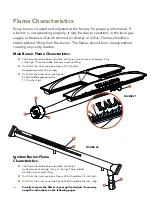
1.800.868.1699
45
Grilling Basics: Grilling Better
A few key skills make grilling more satisfying and successful. The following tips and
tricks represent some of the best of what we have learned from cooking with fire over
the years.
Whole Chicken
More than rotisserie, “Beer Can” or other popular methods for cooking a whole chicken, we prefer
to butterfly and roast it. Butterflying a chicken (also called spatchcock) lays the bird flat for quicker and more even
cooking. A butterflied chicken can be cooked at higher temperatures, so you are able to more easily achieve a nice,
crispy skin and perfectly cooked meat. Whether using a barbecue rub or simply brushing the bird with olive oil, this
is our favorite way to prepare chicken. It takes about 35 minutes for a whole fryer (a smaller chicken than a roaster
chicken) laid directly on the grill grate in the indirect cooking zone at 500°F. Remove the bird when the juices from
a prick in the thigh meat run clear or when an instant-read meat thermometer reads 170°F. (The USDA recommends
180°F. See page 68 for a complete Food Temperature Chart.)
To butterfly a chicken, use kitchen shears to cut out the backbone and discard it. Without cutting through the breast
meat, snip the breast bone part way down the middle from the top. Open the chicken out flat with the skin-side-up.
The thighs should point in toward the middle with the drumsticks pointing out the back. Tuck the wings up and under
as shown in the photo at left.
Chicken Breasts
The challenge with cooking a boneless chicken breast perfectly is the shape: thick at one end and
pointed at the other. For even grilling, a “palliard,” which flattens the breast to a uniform thickness, will yield juicy and
tender results throughout. Place the breast between two layers of heavy plastic (split open a zip-top freezer bag and
place it between the layers) and then pound it to about 1/2-inch thick. Brush each breast with olive oil, sprinkle with
salt and grill directly over a hot fire for a few minutes per side until cooked through but still juicy and tender.
Burgers
First, try to select USDA Choice grade beef. Choice ground round is a good way to go. It improves the
quality of a burger far more than it increases the price. Ground round is delivered to most markets in a tube-shaped
plastic bag. Ask the butcher to cut off 1-inch-thick slices, creating patties that are about ½ pound each. This is the
perfect thickness and weight for the grill. The lack of handling helps with the texture. Forming the patties rather than
slicing them can lead to overworking the burgers, and they can end up a little tough.
Chef Bobby Flay offers a tip to compensate for the way a juicy burger plumps up on the grill. By recessing the patty in
the middle before cooking, the burger becomes flat when it plumps up. Just use your fingers to recess the middle of
each patty a bit from both sides.
The next step in a perfect burger is to brush it with olive oil. This helps form the flavorful crust that is one of the
hallmarks of a great burger. Grill the burgers directly over a medium-hot fire (about 450°F), turning only once, until it
is cooked to the desired doneness. When cooking for larger parties, it can be a good idea to cook an extra, sacrificial
burger. Break into this burger a couple of minutes before you expect the burgers to be cooked to medium to check
your timing. Continue cooking to at least medium-well, an internal temperature of 160°F.
Skirt Steak
Skirt steak should be cooked quickly over a hot fire to medium doneness — no more, no less. Squeeze
a lime over the steak, then brush it with olive oil, sprinkle it with salt and toss it over a wood fire. When prepared
properly, skirt steak is tender and full of flavor. After letting it rest a few minutes, slice skirt steak across the grain to
compensate for its stringy character.
Filet Mignon
Our favorite way to cook filet is to sear it directly over a hot wood fire and then move it to an indirect
cooking zone, close the hood and let it coast up to temperature for 15 to 20 minutes. This creates a nicely browned
exterior crust and a tender, juicy center. As with all steaks, lightly oil and salt the filets before they hit the grill. The
searing is done at about 700°F, and the indirect time is spent at about 500°F. This turns each filet into a miniature
tenderloin roast.
Содержание Outdoor Gourmet K500HB
Страница 1: ...Kalamazoo Hybrid Fire Grills U S E A N D C A R E G U I D E ...
Страница 2: ......
Страница 6: ...www KalamazooGourmet com 2 ...
Страница 8: ...www KalamazooGourmet com 4 ...
Страница 44: ...40 ...
Страница 46: ...42 ...
Страница 48: ...44 ...
Страница 50: ...46 ...
Страница 52: ...48 ...
Страница 54: ...50 ...
Страница 56: ...52 ...
Страница 58: ...54 ...
Страница 60: ...www KalamazooGourmet com 56 ...
Страница 62: ...www KalamazooGourmet com 58 ...
Страница 64: ...60 ...
Страница 66: ...62 ...
Страница 68: ...www KalamazooGourmet com 64 ...
Страница 70: ...66 ...
Страница 86: ...www KalamazooGourmet com 82 ...
Страница 89: ......
Страница 90: ......
















































